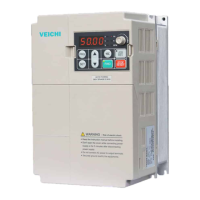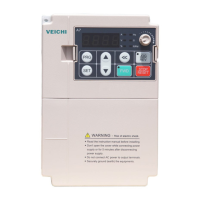Do you have a question about the Veichi AC200-L Series and is the answer not in the manual?
Illustrates the wire drawing machine's control diagram with frequency conversion.
Provides physical dimensions and mounting hole specifications for inverter models.
Describes setting the tension balance bar feedback for optimal PID control.
Details settings for jog and inching operation frequency and acceleration/deceleration times.
Explains the automatic calculation of winding diameter for constant tension.
Defines mechanical transmission ratio and its importance for drawing effect.
Explains resetting winding diameter for synchronization when changing coils.
Details recommended wiring connections for host and take-up machines.
Describes the functions and settings of multi-function input and output terminals.
Details various special function parameters for wire drawing machine control.
Lists monitoring codes for checking inverter status and parameters.
Provides recommended parameter settings for straight wire drawing machines.
Offers recommended parameter settings for water tank type dual frequency hosts.
Provides recommended parameter settings for water tank type double frequency take-up machines.
Explains wiring connections between the host and take-up frequency converters.
Details connecting the tension balance bar potentiometer for feedback.
Describes the necessity and wiring of an external braking resistor.
Explains how the inverter detects and handles line disconnection faults.
Details the control logic for activating the brake signal and its timing.
| Cooling Method | Forced air cooling |
|---|---|
| Enclosure Rating | IP20 |
| Input Voltage | 3-phase 380V ±15% |
| Output Voltage | 0~Rated Input Voltage |
| Input Frequency | 50/60Hz |
| Output Frequency | 0~600Hz |
| Control Mode | V/F control |
| Power Range | 0.4kW |
| Rated Output Current | Depends on model |
| Overload Capacity | 150% for 60 seconds, 180% for 10 seconds |
| Protection Features | Overcurrent, overvoltage, undervoltage, overload, overheat, short circuit |
| Communication Interfaces | RS485, Modbus |
| Operating Temperature | -10°C to +50°C |
| Storage Temperature | -20°C to 60°C |
| Altitude | Less than 1000m (Derating if above 1000m) |












